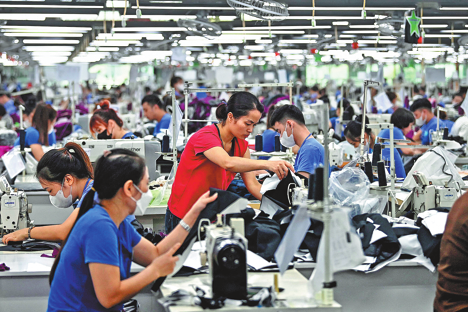Optimism stays in frame for art scene

Resilience seen among Asian buyers, with China recovery aiding prospects
Gallery owner Meg Maggio is optimistic about the prospects for the Asian art market in 2021, believing buyers' appetite will hold up even as the coronavirus changes how the players connect.
Maggio, the director of Pekin Fine Arts, with contemporary art galleries in Beijing and Hong Kong, has witnessed how the ranks of the region's art collectors have expanded in the past few years, and hopes that the buyers will remain in the market.
"The art market moves in tandem with the economy. What comes first is the foundation of Asian economic growth ... it doesn't look like it's affected too much (by the pandemic). And that's because of the strength of domestic consumption," said Maggio, who is from the United States.
Art market players largely share Maggio's assessment. While they acknowledge that sales may have come down in 2020 from the previous year, they point to a steady client base in the region. This is best exemplified by the prices that auction houses managed to secure in 2020.
Christie's Asia's five auctions in December generated over $224 million in sales, according to a statement released by the British auction house. Some of the auctions' top sellers include Goldfish by Chinese-French modernist painter Sanyu, which sold for over $22 million; Bloodline: Big Family No. 2 by contemporary Chinese artist Zhang Xiaogang, which fetched $12.7 million; and Pumpkin by Japanese contemporary artist Yayoi Kusama, which sold for nearly $2 million.
Alan Lau, co-chair of Tate Modern's Asia Acquisition Committee and Guggenheim's Asia Art Circle, is not surprised by the auction houses' huge sales. He cites the influence of China, the world's third-largest art market after the United States and the United Kingdom.
Chinese art sales in 2019 were estimated at $11.7 billion, accounting for 18 percent of the global market, according to an annual global art market report by Swiss investment bank UBS and Art Basel.
"In general, Chinese consumers' balance sheets are very strong. So it's not surprising to see the strong results not just in auctions, but also in art fairs," Lau said.
Lau, also chairman of Tencent's insurance platform WeSure, said international galleries are bringing their best works to Asian collectors who are "demonstrating strong appetite to acquire".
"While some (Asian collectors) are asking for discounted rates, far more are using this opportunity to collect and access art that have a long waiting queue before, and now become available as demand in other parts of the world scales back," he said.
Asian art industry experts said that apart from high-net worth individuals, mid-tier buyers are also in the market.
Accessible works
Maggio said the growing population of the middle class in Asia has more disposable income and, unlike buyers in the US, people in the region usually buy artworks with cash. The mid-tier buyers on average buy artworks worth under $5,000 and start their collection by purchasing more accessible works like art prints.
Maggio said free admissions are common in art galleries and museums in Asia and that some exhibitions are even held in shopping malls, making art "more popularized, more accessible". And Asian buyers tend to collect Asian art, noting that the buyers "appreciate their own culture and want to live with art of their culture".
Andy Hei, founder and director of international art fair Fine Art Asia, said Asian collectors are also increasingly aware that art is another form of investment, and that they are buying art through different platforms.
Hei said social distancing and lockdown measures kept art lovers from visiting galleries and art fairs in 2020, prompting them to go online to view and buy art.
"Because of travel restrictions, collectors can't visit galleries and artists that often, so they rely on online and mobile platforms more than ever," he said.
UBS and Art Basel's midyear global survey of galleries revealed that the share of online art sales rose from 10 percent of total sales in 2019 to 37 percent in the first half of 2020. More than 20 percent of the online buyers were new clients.
However, "most collectors were still actively planning to go to exhibitions, art fairs, and events in the next 12 months, and a majority hoped to attend these events both locally and overseas", UBS and Art Basel said in their joint report.
































